Modelsvit 1/48 Curtiss XP-55 "Ascender"
HISTORY
The Curtiss XP-55 Ascender was a response to Circular Proposal R-40C, issued on November 27, 1939, which called for a fighter more effective than any currently operational - with a superior top speed, rate of climb, maneuverability, armament, and pilot visibility. Additionally, it was to have a low initial cost and be easy and inexpensive to maintain. R-40C specifically stated that aircraft with unconventional configurations would be considered. It was at the time the most ambitious proposal ever put forward by the Air Corps.
Fifty responses were received, most of which were quickly ruled out. By the end of 1940, four designs submitted by Bell, Curtiss, Northrop, and Vultee were considered worthy of further study.
The Curtiss entry was designated CW-24 by the company, and was perhaps the most unconventional of the four finalists. It was the last project supervised by Chief Designer Donovan Berlin before he left Curtiss to go to Fisher and work on the P-75. The CW-24 was a swept-wing pusher aircraft with canard elevators. The low-mounted wings were equipped with ailerons and flaps on the trailing edge with vertical stabilizers and rudders mounted near the wing tips above and below the airfoil. The elevators were located near the nose. A retractable tricycle undercarriage was used, the first time such had been employed in a Curtiss fighter. Curtiss planned to use the new and untried Pratt & Whitney X-1800-A3G (later enlarged as the XH-2600, an H-block aircraft engine with an expected power output of 2,200 hp with a turbocharger) mounted behind the pilot's cockpit. Projected maximum speed was no less than 507 mph. Curtiss received an Army contract for preliminary engineering data and a powered wind tunnel model on June 22, 1940. The project was given the designation P-55. The name “Ascender” originated as a pun on the part of a Curtiss engineer. The name stuck, and eventually became official.
In the event, the Vultee (XP-54), Curtiss (XP-55), and Northrop (XP-56) designs, as well as the Lockheed XP-49 and XP-58 Chain Lightning, would all fail due to each new design depending on the undeveloped XH-2600 engine to provide the promised performance. The engine encountered numerous development delays and was eventually cancelled after only one was produced.
The USAAC was not completely satisfied with the wind tunnel tests, and Curtiss built a flying full-scale model to prove the concept. Designated CW-24B, the flying testbed was powered by a 275 hp Menasco C68-5 engine and had a fabric-covered, welded steel tube fuselage and a wooden wing, with a fixed undercarriage. The CW-24B was shipped to the Army flight test center at Muroc Dry Lake in California, where it made its first flight on December 2, 1941. Although maximum speed was only 180 mph, the CW-24B proved the feasibility of the concept. However, early flights indicated there was directional instability. To cure this, the original wingtip fins were increased in area and moved four feet further outboard on the wings; the result was enhanced directional stability. Additionally, the wingtips were increased in span and vertical fins were place on the top and bottom of the engine cowling. The CW-24B made 169 flights at Muroc between December 1941 and May 1942. After that, the airplane (assigned the USAAC serial number 42-39347) was transferred to Langley Field, Virginia, for further testing by NACA.
While the flight testing of the CW-24B proceeded, work on the full-scale CW-24 continued. On July 10, 1942, a contract was issued for three prototypes designated XP-55, with serial numbers 42-78845/78846/78847. Because the Pratt & Whitney X-1800 engine was experiencing serious developmental delay, Curtiss switched to the Allison V-1710 (F16) engine due to reliability and availability. Armament was originally planned as two 20-mm cannon and two 50-caliber machine guns. However, during the mockup phase, the lower-powered 1275 hp Allison V-1710-95 engine was substituted, with the two 20-mm cannon replaced by 50-caliber machine guns.
The first XP-55, serial 42-78845, was completed July 13, 1943, featuring the same configuration as the final CW-24B. The first test flight occurred on July 19, 1943 at Scott Field near the Curtiss St Louis plant, flown by Curtiss test pilot J. Harvey Gray. Initial flight tests showed the takeoff run was excessively long. In order to solve this, the canard elevator was increased in area and the aileron up trim was interconnected with the flaps so it operated when the flaps were lowered.
On November 15, 1943, Gray was conducting a series of stall tests when the aircraft suddenly went inverted and fell into an uncontrolled dive, falling 16,000 feet before Gray was able to parachute to safety. The first prototype was destroyed in the ensuing crash.
At the time of the crash, the second XP-55 (42-78846) was too far advanced in construction to be conveniently modified to incorporate any changes resulting from analysis of the crash cause. The second XP-55 was essentially similar to the first, apart from a slightly larger canard with a modified elevator tab system, and balance tabs replaced by spring tabs on the ailerons. The second XP-55 first flew on January 9, 1944. Stalls were restricted until the third XP-55 had been modified and tested.
The third XP-55 (42-78847) made its first flight on April 25, 1944. It carried the designed armament of four machine guns and incorporated modifications resulting from the crash investigation of the first prototype. Stall characteristics were improved by adding four-foot wingtip extensions and by increasing the limits of the canard's elevator travel. The first flight revealed that the increased elevator limit resulted in the pilot being able to hold such a nose-high angle during takeoff that the canard could stall. After further modification, stall tests were performed satisfactorily, though the complete lack of any stall warning and the excessive loss of altitude necessary to return to level flight were undesirable.
An artificial stall warning device was fitted to correct these problems. The second prototype was also brought up to the same standard as the third, and underwent official trials between September 16-October 2, 1944. The tests demonstrated the XP-55 had satisfactory handling during level and climbing flight, but there was a tendency on the part of the pilot to over-control the elevators at low speeds and during landings due to a lack of any useful "feel." Stall warning was still insufficient, and stall recovery still involved an excessive loss of altitude. Engine cooling was also a problem.
With an engine providing only a bit more than half the power originally expected from the XH-5600 engine, the XP-55's performance was unimpressive and in fact inferior to the more conventional fighters in service, with a maximum speed of 390 mph at 19,300 feet and 377.5 mph at 16,900 feet, while taking 7.1 minutes to attain 20,000 ft. By 1944, jet-powered aircraft were clearly the wave of the future and further development was abandoned.
The third prototype was destroyed in a crash during an airshow at Wright Field on May 27, 1945, killing the pilot. The surviving XP-55 (42-78846) was flown to Warner-Robins Field in Georgia in May 1945 and was later taken to Freeman Field for transfer to the National Air Museum at the Smithsonian. The fuselage was on display at the Paul Garber facility in Suitland, Maryland for many years until December, 2001, when the XP-55 was sent to the Kalamazoo Aviation Museum for restoration, which was completed in 2007. The XP-55 is now on display in the Main building of the Kalamazoo Airzoo.
THE KIT
This kit of the XP-55 released by Modelsvit of Ukraine in 2018 is the second 1/48 kit of the aircraft, the first being a very limited-run kit made by MPM under the label Czech Model for Squadron and released in 1998.
Modelsvit is known for releasing a series of 1/72 Soviet Cold War jets, and a series of 1/48 Yak-1/7/9 fighters. These are all limited-run kits, but they are very high-quality for that term, with detailed cockpits and landing gear, and very nice surface detail and good parts fit. In fact, once completed, these kits look nothing like what one expects from the description “limited run.”
This XP-55 kit has 141 plastic parts on six trees that sport whiffs of flash that is easily cleaned up, with a 22–part photoetch fret that includes seat belts and detail parts for the cockpit and landing gear. The highly-detailed cockpit takes around a third of the total parts, with the landing gear being highly detailed. Crystal-clear canopy parts are provided for both open and closed options, along with painting masks. Decals provide markings for both the second and third prototypes along with complete stenciling. The 8-page instructions are comprehensive.
You can find comprehensive walkaround photos of the surviving XP-55 at the Kalamazoo musuem that were taken by my friend Michael Benolkin with modelers in mind, at his site, Cybermodeler . I found the detail photos of the landing gear very useful in constructing those sub-assemblies, and I recommend anyone building this kit consult that site.
CONSTRUCTION
I decided to commit the radical act of following the instructions, which made construction quite easy. One must remember that this is a limited-run kit and exercise care in cutting the delicate small parts off the sprues, which are thicker than mainstream injection kits. Test-fit before gluing and all will be well.
I started by painting all the cockpit parts Interior Green, then painting various details according to the instructions, photo-etch instrument panels are supplied, with decals as a second option. I used the photo-etch part with the decal backing for the instruments of the main panel, and used the decal options for the two secondary side panels. I replaced the kit's photoetch seatbelts with Eduard steel seatbelts, mostly because the Eduard pieces are already painted. Had I not had them at hand, the kit parts would have been fine. I then attached the assembled cockpit in a fuselage half and then glued the halves together. Fit was excellent.
I then assembled the wing sub-assembly. I found the detail photos very useful, since they revealed that the main gear wells are painted with Yellow Zinc Chromate, with Olive-Drab painted canvas side walls; this is different from the kit callout for overall interior green. The photos also show that the gear legs are painted Olive-Drab with the main gear hubs natural metal and the nosewheel hub Olive-Drab.
With care in attaching the two main sub-assemblies, there were only minor seams to deal with. I assembled and attached the lower air scoop, then used Mr Surfacer on the seams. Once sanded smooth, I rescribed the lost detail, which is very petite.
COLORS & MARKINGS
The photos of the restored XP-55 show that it was painted green-base Olive Drab on the upper surfaces and Light Aircraft Grey rather than Neutral Grey on the lower surfaces. I used Tamiya “Royal Light Grey” XF-80 for the lower color and “RAF Dark Green” XF-81 (RAF Dark Green and USAAC green-base OD-41 are the same color, based on the specification for World War I RAF P.C.10). I gave the model a coat of clear gloss to finish.
I substituted Fundekals US National Insignia decals for the kit decals, just because the Fundekals are a bit better (the kit decals would be fine otherwise) and used the kit decals to make 42-78846, the surviving XP-55. The kit decals went down with a dab of Micro-Sol without problems.
I gave the model a coat of clear flat. When that was dry, I masked off the panels around the exhaust that were unpainted on the original and painted them with Vallejo Duraluminum color.
I unmasked the canopy and attached the sliding parts in the open position. I then attached the landing gear with the aid of referencing the photos, and attached the prop.
CONCLUSIONS
It's really hard to believe, looking at the completed model, that this isn't a Tamigawa or Eduard release. With careful assembly, there was none of the problems one normally associates with a “limited run” kit. The end result is an excellent representation of this very interesting airplane. The kit is highly-recommended for modelers who are experienced with doing limited-run kits.
Modelsvit has already shown photos of test-pressings of a 1/48 P-51H that has been announced as a November 2019 release. The surface detail is as petite as it is on this kit, and looks like it will result in a model fully comparable to the recent Eduard P-51D. The company has also announced a 1/48 F-82E/G kit for release in 2020. Based on what they have done with this XP-55 kit, those should be highly-anticipated releases.
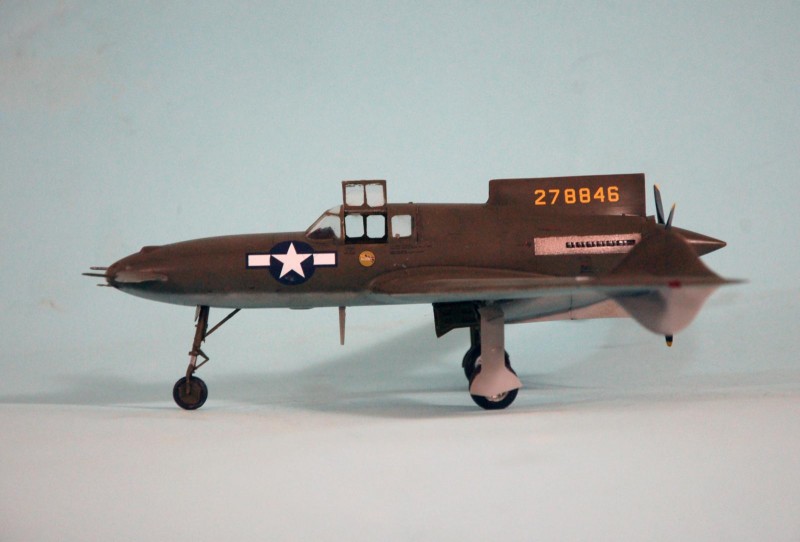
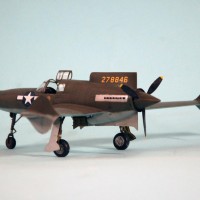
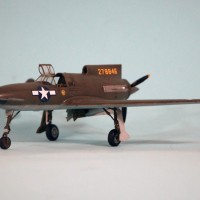
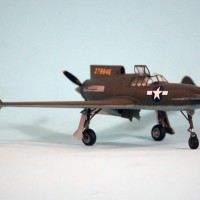
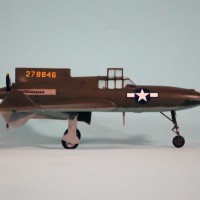
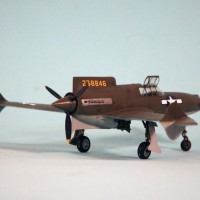
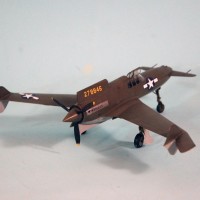
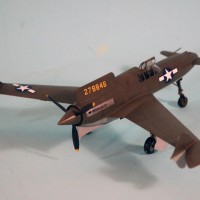
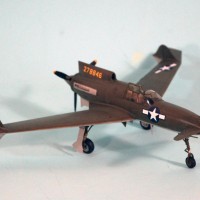
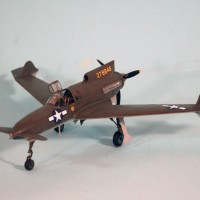
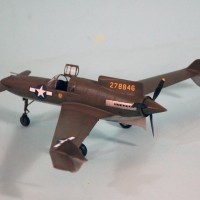
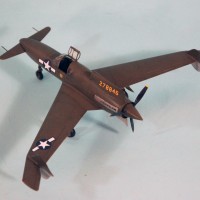

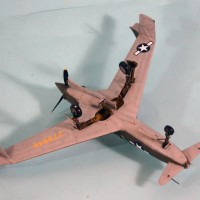
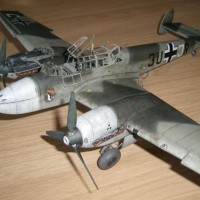
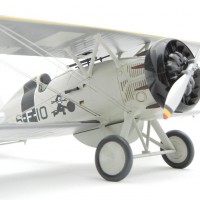
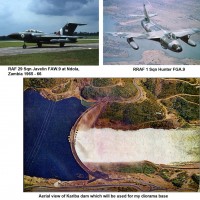
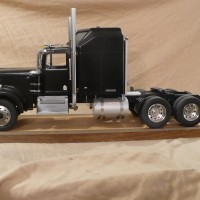
Tom you have knocked this one out of the ball park for a home run. I definitely want this kit now, especially after seeing how great your Ascender turned out. Well done and thanks for posting it and the usual great history lesson that is to be expected from you!
Nice job Tom. Interesting observation on who wears what green also. Love the lines of this airframe.
A very clean rendition of a rare bird. Love it!
Nice build and the great subject, Tom! Also have this kit in my stash, and now I'm collecting the references.
Thank you for this post. A piece of interesting technological history.
Cool looking aircraft. Like a mix of the Japanese Shinden and the Swedish J21.
Reminds me of a Vari-Eze.
Great report on an interesting subject ... as usual ... Tom! Great looking model, too!
You wrote: "The name “Ascender” originated as a pun on the part of a Curtiss engineer." I guess A$$-ender wouldn't be very "Public Friendly," would it?! LoL!
Thanks for your retelling of history. @tcinla
Yep - what they said, TC.
Now, that is what you get when you follow the instructions!
No, seriously, well done - and thank you for sharing the story and build.
Great work Tom! I bought one of these on EBAY when they first came out. Planning on doing soon. How much weight did you put in the nose?
I filled the half the nose with fish weights.
Now that's different, looks great.Looks like something out of an early sci-fi story.
Now I know where Manga Storyboard people got their inspiration for some “wingy” themed series.
Nice one Tom, as usual. Got me curious enough to check online the kit but was put off by the price tag... perhaps that P-51 H will get some funding
I'm surprised by your comment, Pedro, given that so far as i have discovered, the price of this kit is around US$ 35.00, which nowadays is "not that much." Of course, the possibility I am looking at US distributors could make the difference. But I think if you check eBay, or check Modelsvit themselves, you should be able to find the kit you are looking for.
Tom, I understand what you mean... 35 US dollars is the “norm” these days for a 1/48 kit, however this one sells for a much hefty price this side of the pond, almost 50 euros plus p&p 🙁
For such a price tag it has to be something I want bad, and the Ascender just isn’t in this category.
Pedro:
30.99 Pounds at Hannant's
https://www.hannants.co.uk/product/MSVIT48008
wonderful piece of work...brilliant photography...splendid subject...bravo
I'll have to get this to go with my XP-56! (Someone at some point had a 1/48 XP-54 as well.) Great news on the 1/48 P-82! Seeing the XP-82 in the air this summer was a treat!
Thanks for this info. I have this one lurking on my shelf, but I was waiting to build it until someone had taken a good look at any vices it might have. Now that you have paved the way, I think it may be time to jump into building the plane. Great job!
I always thought it was a cool-looking aircraft - I've got the 1/72 version (Special Hobby maybe? Which means not as nice to put together obviously!). Yours looks great!